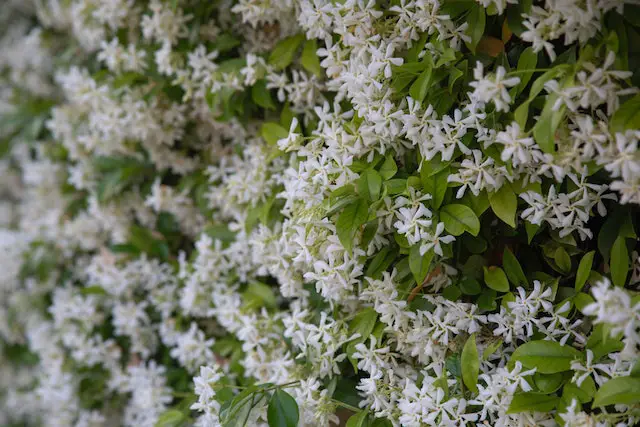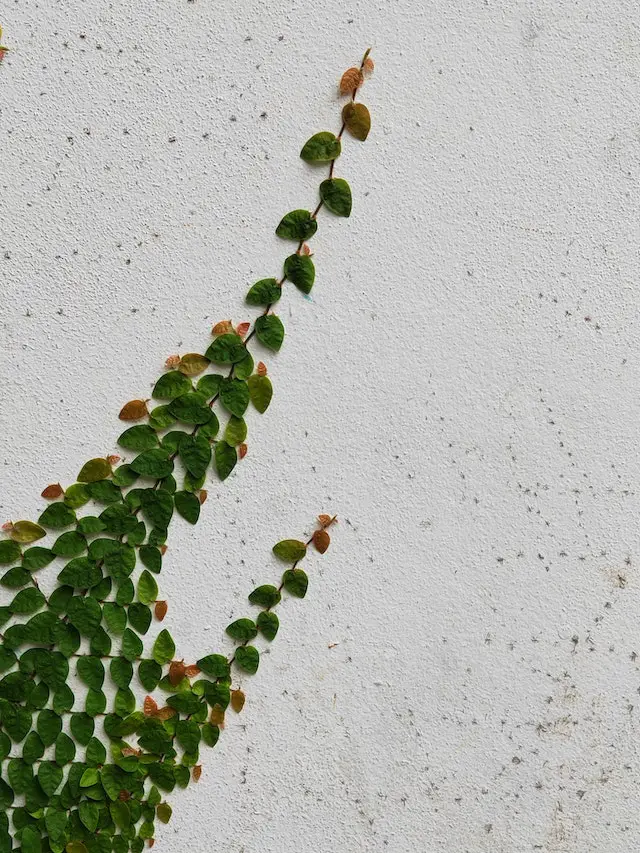When it comes to choosing the perfect climbing plant for your garden, the decision can be a tough one. With so many options available, it’s easy to feel overwhelmed. In this article, we’ll take a deep dive into the world of two popular climbing plants: the creeping fig (Ficus pumila) and the star jasmine (Trachelospermum jasminoides).
Both have their unique characteristics, and we’ll explore the pros and cons of each to help you decide which one is the best fit for your garden.
A Brief Comparison Table
| Feature | Creeping Fig (Ficus pumila) | Star Jasmine (Trachelospermum jasminoides) |
| Family | Moraceae (Mulberry family) | Apocynaceae (Dogbane family) |
| Origin | China, Japan, and Vietnam | China and Japan |
| Growth Habit | Evergreen vine | Evergreen vine |
| Mature Size | Up to 30 ft. (9 m) long | Up to 20 ft. (6 m) long |
| Growth Rate | Fast | Moderate to fast |
| Hardiness Zones | USDA Zones 8-11 | USDA Zones 8-11 |
| Soil Preference | Well-drained, fertile soil | Well-drained, fertile soil |
| Light Requirements | Full sun to partial shade | Full sun to partial shade |
| Water Requirements | Moderate, drought-tolerant | Moderate, drought-tolerant |
| Foliage | Small, heart-shaped leaves | Glossy, dark green, oval-shaped leaves |
| Flowers | Inconspicuous | Fragrant, white, star-shaped flowers |
| Bloom Time | Rarely blooms | Late spring to early summer |
| Fruiting | Small, inedible figs | Small, inedible fruit |
| Pruning | Regular pruning to control growth | Prune after flowering to maintain shape |
| Pests/Diseases | Scale, mealybugs, root-knot nematodes | Aphids, scale, spider mites |
| Invasiveness | Can be invasive, especially in warmer climates | Less invasive, but may spread if not managed |
| Ideal for | Ground cover, walls, fences, trellises | Ground cover, walls, fences, trellises, arbors |
| Attracts | Birds, insects | Birds, butterflies, bees |
| Other Uses | Erosion control, topiary | Aromatic gardens, cut flowers |
| Maintenance Level | Moderate to high | Moderate |
Both creeping fig and star jasmine are popular, evergreen vines that can provide excellent ground cover or climb walls and fences. The main difference between the two is the appearance of their foliage and flowers.
Creeping fig has small, heart-shaped leaves and rarely blooms, while star jasmine has glossy, dark green leaves and produces fragrant, white, star-shaped flowers in late spring to early summer. While both plants can be invasive if not managed properly, creeping fig is generally considered to be more invasive, especially in warmer climates.
Read More: About Fine Spray Watering Can for Seedlings
The Backstory: Creeping Fig and Star Jasmine
Creeping fig and star jasmine are both popular choices for gardeners who want a climbing plant that can cover walls, fences, or trellises with ease. Originally from East Asia, the creeping fig is a fast-growing evergreen vine that’s a member of the fig family, while the star jasmine, native to Southeast Asia, is an evergreen or semi-evergreen vine that belongs to the Apocynaceae family.

Creeping Fig: The Pros
- Rapid Growth
One of the most significant advantages of the creeping fig is its rapid growth rate. This vine can cover a large area in a relatively short amount of time, which can be especially useful if you’re looking to create a green wall or a dense screen.
- Evergreen Foliage
The creeping fig is an evergreen plant, meaning it retains its leaves throughout the year, providing continuous greenery and coverage. This can be an attractive feature for gardeners who want to maintain a lush appearance in their outdoor space.
- Tolerant of Different Light Conditions
Creeping fig can thrive in various light conditions, from full sun to partial shade. This makes it a versatile option for gardeners with different sun exposures in their yards.
Creeping Fig: The Cons
- Aggressive Growth
While the creeping fig’s rapid growth can be an advantage, it can also be a drawback. Its aggressive nature means it can overtake other plants and require constant maintenance to keep it in check.
- Potential Damage to Structures
Creeping fig can adhere to surfaces with its aerial roots, which can cause damage to structures like walls and fences over time. This is especially true for delicate or historic buildings.
3. Invasive Species
In some regions, creeping fig is considered an invasive species due to its rapid growth and ability to displace native plants. This can have negative impacts on local ecosystems.

Star Jasmine: The Pros
- Fragrant Flowers
One of the main attractions of star jasmine is its fragrant, star-shaped flowers. These white blooms emit a sweet scent that can fill your garden with a delightful fragrance.
- Versatility
Star jasmine is a versatile plant that can be trained to grow up trellises, walls, and fences, or even as a ground cover. This adaptability makes it an appealing choice for a variety of garden settings.
- Attractive Foliage
In addition to its fragrant flowers, star jasmine also boasts glossy, dark green leaves that provide a visually appealing contrast to its blooms.
Star Jasmine: The Cons
- Slower Growth Rate
Compared to the creeping fig, star jasmine has a slower growth rate. While this may be preferable for some gardeners, it can be a disadvantage if you’re looking for rapid coverage.
- Less Tolerant of Cold Temperatures
Star jasmine is less cold-hardy than the creeping fig, which means it may not fare well in regions with harsh winter climates.
- Requires More Maintenance
Star jasmine requires regular pruning to maintain its shape and encourage healthy growth. This can be a disadvantage for gardeners who prefer low-maintenance plants.
Additional Considerations: Creeping Fig and Star Jasmine
To further help you in your decision-making process, let’s explore some additional aspects of both creeping fig and star jasmine that may impact your choice.
Soil Requirements
Both creeping fig and star jasmine are relatively adaptable when it comes to soil conditions. They can tolerate various soil types, including loamy, sandy, and clay soils, as long as there is good drainage. However, star jasmine prefers slightly acidic to neutral soil (pH 6.0 to 7.0), while creeping fig can tolerate a broader pH range.
Watering Needs
Creeping fig and star jasmine have different watering requirements. Creeping fig prefers consistently moist soil, especially during the growing season, but can tolerate periods of drought once established. On the other hand, star jasmine requires moderate watering, with a preference for slightly drier soil in the winter months to prevent root rot.
Fertilization
Both plants can benefit from regular fertilization during the growing season. Creeping fig typically requires a balanced, slow-release fertilizer applied every six to eight weeks. Star jasmine, on the other hand, benefits from a high-potassium fertilizer during the spring and summer to encourage flowering.
Pests and Diseases
Creeping fig is relatively resistant to pests and diseases, but it can occasionally attract scale insects, mealybugs, or spider mites. Star jasmine is also relatively pest-free but can be affected by whiteflies, aphids, or scale insects. Regularly inspecting your plants and applying appropriate treatments can help keep these pests under control.
Enhancing Your Garden with Creeping Fig or Star Jasmine
Regardless of your choice between creeping fig and star jasmine, both plants can add visual interest and texture to your garden. Here are a few ideas to incorporate these climbing plants into your landscape:
- Creating a living wall
Both creeping fig and star jasmine can be used to create an attractive living wall or green facade, providing privacy and improving the aesthetics of your outdoor space.
- Accentuating architectural features
Use these climbing plants to highlight and accentuate specific architectural elements in your garden, such as archways, pergolas, or columns.
- Camouflaging unsightly structures
If you have an unsightly fence or wall, both creeping fig and star jasmine can be used to effectively camouflage and beautify these structures.
- Creating a focal point
Train these plants to grow up a trellis or obelisk to create a striking focal point in your garden.
Ultimately, the decision between creeping fig and star jasmine comes down to your personal preferences, garden conditions, and desired aesthetic. By taking the time to weigh the pros and cons of each plant, you can make an informed decision and create a garden that reflects your unique style and vision.
Read More: About How Far Away To Plant Corn From Tomatoes
Frequently Asked Questions (FAQs)
There are several other climbing vines that share similar characteristics with creeping figs, such as:
English ivy (Hedera helix)
Boston ivy (Parthenocissus tricuspidata)
Virginia creeper (Parthenocissus quinquefolia)
Algerian ivy (Hedera canariensis)
Yes, creeping fig is an evergreen plant, which means it maintains its green foliage throughout the year.
Creeping fig can be relatively easy to maintain if you’re prepared to manage its aggressive growth. Regular pruning and trimming are required to prevent it from overtaking other plants and structures in your garden.
Creeping fig can potentially be destructive, particularly to walls and fences. Its aerial roots can cause damage to delicate or historic structures over time. It’s essential to carefully consider where you plant creeping fig and monitor its growth to avoid any potential issues.
The main issue with creeping fig is its aggressive growth, which can cause it to overtake other plants and damage structures. In some regions, it’s also considered an invasive species, which can negatively impact local ecosystems.
While creeping fig itself may not specifically attract rats, any dense foliage, including that of creeping fig, can provide shelter and hiding spots for rodents and other pests. Regular maintenance and monitoring of the plant can help reduce the risk of attracting unwanted visitors to your garden.
The Verdict: Creeping Fig vs Star Jasmine
In conclusion, both creeping fig and star jasmine have their unique advantages and drawbacks. The choice between the two ultimately depends on your specific needs and preferences as a gardener.
If you’re looking for a fast-growing, evergreen vine that can cover large areas quickly, the creeping fig may be the right choice for you. However, be prepared to manage its aggressive growth and potential damage to structures.
On the other hand, if you prefer a climbing plant with fragrant flowers and attractive foliage that can be trained to grow in various ways, star jasmine may be the better option. Keep in mind, though, that it requires more maintenance and may not be suitable for colder climates.
By carefully considering the pros and cons of each plant, you’ll be well-equipped to make an informed decision and select the perfect climbing plant for your garden.
Auto Amazon Links: No products found.
Perfect Plants Christmas Tree Saver 8oz. | Easy Use Xmas Tree Preserver Food | Have Healthy Green Christmas Trees All Holiday Season
$7.99 (as of December 26, 2025 06:42 GMT +00:00 - More info- Product prices and availability are accurate as of the date/time indicated and are subject to change. Any price and availability information displayed on [relevant Amazon Site(s), as applicable] at the time of purchase will apply to the purchase of this product.
FirEver Pure Christmas Tree Food | Preserver Additive & Season Extender for Live Xmas Trees | Keep It Green, Reduce Needle-Drop | Miracle Freshness (8 oz)
$9.16 (as of December 26, 2025 06:42 GMT +00:00 - More info- Product prices and availability are accurate as of the date/time indicated and are subject to change. Any price and availability information displayed on [relevant Amazon Site(s), as applicable] at the time of purchase will apply to the purchase of this product.
Wilt-Pruf® Christmas Tree/Cutting Preserver Spray |Preserves Christmas Trees, Wreaths, Garlands, Cuttings and Carved Pumpkins | Reduces Needle Drop | Keeps Cut Trees Fresh Longer | Natural (32 oz)
$21.99 (as of December 26, 2025 06:42 GMT +00:00 - More info- Product prices and availability are accurate as of the date/time indicated and are subject to change. Any price and availability information displayed on [relevant Amazon Site(s), as applicable] at the time of purchase will apply to the purchase of this product.
Transmission Funnel - 3'' Wide 23'' Long Funnel with Hose – Flexible, Reusable, No Leak Design Featuring Elastic Long Hose | Long Funnel for Oil, Gas, Coolant, Automotive and Garage Applications
$7.95 (as of December 26, 2025 06:42 GMT +00:00 - More info- Product prices and availability are accurate as of the date/time indicated and are subject to change. Any price and availability information displayed on [relevant Amazon Site(s), as applicable] at the time of purchase will apply to the purchase of this product.
Rocky Mountain Goods Christmas Tree Food - 8 oz Tree Preservative - Reduce Needle Drop - Greener Scent - Fir, Pine, Spruce Trees - Extend Tree Life
$9.95 (as of December 26, 2025 06:42 GMT +00:00 - More info- Product prices and availability are accurate as of the date/time indicated and are subject to change. Any price and availability information displayed on [relevant Amazon Site(s), as applicable] at the time of purchase will apply to the purchase of this product.
Muddy Mat® | Super Absorbent Door Mat Indoor, Microfiber Quick Dry Chenille Entryway Rug, Non-Slip Front Door Mat, Indoor Mats for Entryway, Machine Washable Pet Rug, Grey 30"x19"
$24.95 (as of December 26, 2025 13:27 GMT +00:00 - More info- Product prices and availability are accurate as of the date/time indicated and are subject to change. Any price and availability information displayed on [relevant Amazon Site(s), as applicable] at the time of purchase will apply to the purchase of this product.
Zevo Flying Insect Trap Official Refill Cartridges - Fits Both Zevo Trap & MAX Indoor Fly Trap - Authentic Trap+Lock Technology to Catch Gnats, House & Fruit Flys (4 Official Refill Cartridges)
$14.97 (as of December 26, 2025 13:27 GMT +00:00 - More info- Product prices and availability are accurate as of the date/time indicated and are subject to change. Any price and availability information displayed on [relevant Amazon Site(s), as applicable] at the time of purchase will apply to the purchase of this product.
OLANLY Dog Door Mat for Muddy Paws 30x20, Absorbs Moisture and Dirt, Absorbent Non-Slip Washable Doormat, Quick Dry Chenille Mud Mat for Dogs, Entry Indoor Entryway Carpet for Inside Floor, Grey
$9.99 (as of December 26, 2025 13:27 GMT +00:00 - More info- Product prices and availability are accurate as of the date/time indicated and are subject to change. Any price and availability information displayed on [relevant Amazon Site(s), as applicable] at the time of purchase will apply to the purchase of this product.
TERRO Ant Killer Bait Stations T300B - Liquid Bait to Eliminate Ants - Bait System - 12 Count Stations for Effective Indoor Ant Control
$10.88 (as of December 26, 2025 13:27 GMT +00:00 - More info- Product prices and availability are accurate as of the date/time indicated and are subject to change. Any price and availability information displayed on [relevant Amazon Site(s), as applicable] at the time of purchase will apply to the purchase of this product.
Snow Joe Premium Enviro Blend Ice Melt, Green-Coated Deicer Crystals, 50 lb - Safer Melter for Vegetation, Concrete & Metals w/ Anti-Corrosion Calcium Magnesium Acetate
$32.97 (as of December 26, 2025 13:27 GMT +00:00 - More info- Product prices and availability are accurate as of the date/time indicated and are subject to change. Any price and availability information displayed on [relevant Amazon Site(s), as applicable] at the time of purchase will apply to the purchase of this product.













